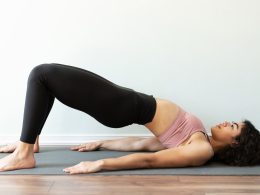Introduction to resistance bands
If you’re new to strength training, or just looking for a different way to mix up your workout routine, resistance bands are a great option. They’re relatively inexpensive, portable, and can be used for a wide range of exercises.
Resistance bands come in a variety of thicknesses, which determine the level of resistance they provide. The thicker the band, the more resistance it offers. If you’re just starting out, it’s a good idea to start with a thinner band and gradually work your way up to a thicker one.
To use resistance bands, simply secure one end around a sturdy object like a door handle or piece of furniture, and hold the other end in your hand. From there, you can do any number of exercises like bicep curls, shoulder presses, rows, and more.
If you’re looking to add resistance bands to your strength-training routine, here are a few tips to get you started:
Start with lighter resistance bands: As mentioned above, if you’re new to using resistance bands, it’s best to start with those that offer less resistance. This will help you get accustomed to the movement and prevent injury.
As mentioned above, if you’re new to using resistance bands, it’s best to start with those that offer less resistance. This will help you get accustomed to the movement and prevent injury. Use proper form: As with any type of strength-training exercise, using proper form is essential when
The different types of resistance bands
Resistance bands are a type of fitness equipment that can be used to improve strength and muscle growth. There are different types of resistance bands, each with its own advantages and disadvantages. The most common types of resistance bands are:
1. Theraband: Theraband is the most popular type of resistance band. It is made of latex and is available in a variety of colors, which indicate the level of resistance. Theraband is very versatile and can be used for a wide range of exercises. However, it is not as durable as other types of resistance bands and can snap if not used correctly.
2. Powerband: Powerband is a type of resistance band that is made of latex or rubber. It is available in different widths and lengths, which determine the level of resistance. Powerbands are very versatile and can be used for a wide range of exercises. They are also more durable than therabands and are less likely to snap.
3. Superband: Superbands are made of latex or rubber and are available in different widths and lengths, which determine the level of resistance. Superbands are the most versatile type of resistance band and can be used for a wide range of exercises. They are also more durable than therabands and powerbands, making them ideal for heavier users.
4. Loop band: Loop bands are made of latex or rubber and come in different sizes, which determine the level of resistance. Loop bands are less versatile
How to use resistance bands for strength training
If you’re like most people, when you think of resistance bands, you probably think of them as a tool for physical therapy or rehabilitation. But the truth is, resistance bands can be an extremely effective tool for strength training and muscle growth.
There are a few different ways to use resistance bands for strength training. The first is to use them as part of your warm-up routine. By attaching the band to a sturdy object (like a door frame) and performing some basic exercises, you can get your muscles warmed up and ready for a workout.
The second way to use resistance bands is to incorporate them into your actual workout routine. For example, if you’re doing biceps curls with dumbbells, you can also attach a resistance band to the dumbbells and do curls with the band as well. This will add extra resistance and help build muscle faster.
Finally, you can also use resistance bands to perform assisted pull-ups and chin-ups. By looping the band around your body and under your arms, you can take some of the weight off of your own body and make these exercises easier to perform. This is especially helpful if you’re just starting out with strength training.
So there you have it! Three different ways to use resistance bands for strength training and muscle growth. Give them a try today!
How to use resistance bands for muscle growth
If you’re looking to add some resistance training to your workout routine, you may be wondering how to use resistance bands for muscle growth. While weights are the more traditional choice for building muscle, resistance bands can be just as effective. Here’s how to use them:
1. Choose the right band. The amount of resistance provided by a band is determined by its thickness. A thicker band will offer more resistance, while a thinner band will be less challenging. If you’re just starting out, it’s best to choose a band with medium resistance.
2. Set up the band properly. Before you begin your exercise, make sure the band is securely attached to something sturdy, like a pole or doorframe. Otherwise, it could come loose and cause injury.
3. Start slow. When using resistance bands for muscle growth, it’s important to start slowly and increase the intensity gradually. If you try to do too much too soon, you could overwork your muscles and experience pain or injury.
4. Perform a variety of exercises. To fully work all the muscles in your body, it’s important to perform a variety of exercises with the resistance band. Some good options include bicep curls, triceps extensions, shoulder presses, and squats.
5. Don’t forget to cool down and stretch afterwards! After completing your workout with the resistance band, be sure to cool down with some light cardio and static stretches for all the major muscle groups involved
Tips for using resistance bands
If you’re new to resistance bands, or strength training in general, starting off with lighter bands is always a good idea. This will help you get a feel for the exercise and prevent injury. As you get stronger, you can move up to heavier bands.
Here are some tips for using resistance bands safely and effectively:
-Warm up before using the bands, just as you would before any other workout. A light jog or dynamic stretching is a great way to get your muscles warm and ready.
-When using the bands, be sure to maintain good form. This means keeping your back straight, shoulders down and away from your ears, and moving slowly and controlled through the entire range of motion.
-Don’t forget to breathe! Holding your breath while working out can lead to dizziness and lightheadedness.
-Resistance bands are a great tool for adding variety to your workout routine. If you’re getting bored with your current routine, try incorporating different exercises with the bands. This will not only keep things interesting, but it will also challenge your muscles in new ways, leading to better results.
Conclusion
In conclusion, using resistance bands is a great way to build muscle and strength. With the right technique and knowledge, you can go from beginner to pro in no time! Resistance bands are versatile pieces of equipment that challenge your muscles in different ways, helping you reach your fitness goals faster. If you are looking for an effective workout routine with customizable intensity levels—resistance band training might be the perfect choice for you!












